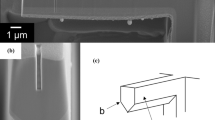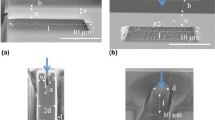Abstract
Structures have been built at micro scales with unique failure mechanism not yet well understood, in particular, under high-rate loading conditions. Consequently, MEMS devices suffer from inconsistent performance and insufficient reliability. This research aims to understanding the failure mechanisms in micro-scaled specimens deforming at high rates. Single crystal silicon micro beams that are 4 μm thick are subjected to tensile loading at average strain rates of 100 s−1 using a miniature modified Kolsky tension bar. A capacitance displacement system and piezoelectric load cell are incorporated to measure the strain and stress of the silicon micro beams directly to ensure precision. Extreme fragmentation of the beams occurs during failure and this phenomenon is observed using a high speed camera. A debris retention system is used to capture the silicon fragments for direct inspection using a Scanning Electron Microscope. The failure mechanism of the micro beams is attributed the presence of sub micron scaled surface defects rather than any one large critical flaw.
Access provided by Autonomous University of Puebla. Download conference paper PDF
Similar content being viewed by others
Keywords
19.1 Extended Abstract
A modified mini Kolsky bar setup was used to subject single crystal silicon micro-specimens to impact tensile loading conditions. The specimens contain a frame that holds a fixed-fixed silicon cantilever that is 4 μm thick and has a width of 0.6 mm and a gage length of 4 mm. The specimens were produced using deep reactive ion etching of a <100> silicon-on-insulator wafer and a shown schematically and physically in Fig. 19.1. Support strips are in place so that the specimen can be handled and are removed once the specimen is fixed in the Kolsky bar apparatus.
The modified Kolsky bar uses of a tubular striker, which is fired via a spring loaded trigger system at a flange. This transmits a wave through the 7075-T651 aluminum incident bar, whose length and diameter are 1.65 m and 0.65 cm respectively. The wave triggers the strain gage that is located 0.86 m from the end of the incident bar where one end of the silicon specimen is fixed. The other end of the specimen is fixed to a rigid body with a 22.24 N capacity load cell which will directly measure the tensile load of the micro specimens. Using a capacitor displacement system that is placed directly at the end of the incident bar, a displacement history is obtained. The capacitor is designed to measure between 1 and 100 μm of displacement and is attached to a precision slide for regular calibration verifications.
Once data has been acquired the stress strain histories of the specimens can be determined using Eqs. 19.1, 19.2, and 19.3, where σ is engineering stress, f is force, A is the cross sectional area, t is time, ε is strain, \( \dot{\varepsilon} \) is strain rate, \( \Delta l \) is displacement, \( {l_{^{\circ}}} \) is initial gage length, and \( v \) is velocity.
The single crystal silicon micro-beams have an average dynamic tensile strength of 1.26 GPa with a standard deviation of 0.310 GPa. The average failure strain of the beams is 0.60 % with a standard deviation of 0.148 %. The dynamic average elastic modulus of the beams is 226.8 GPa with a standard deviation of 18.50 GPa. The average strain rate of the experiments was 92 s−1.
A high speed camera was used to capture the failure event as it occurred. The images were taken at 200,000 frames per second, so the time step interval between images is 5 μs. These high speed images can be seen in Fig. 19.2. The silicon specimen shattered into many pieces rather than failing into two separate pieces at the largest flaw.
Do the size scale and high aspect ratio of the silicon specimens, the current hypothesis to explain the observed failure is that instead of one critical large flaw dominating the failure process, many smaller flaws will run simultaneously, causing multiple fracture pieces.
Author information
Authors and Affiliations
Corresponding author
Editor information
Editors and Affiliations
Rights and permissions
Copyright information
© 2014 The Society for Experimental Mechanics, Inc.
About this paper
Cite this paper
Dubelman, S., Raghunathan, N., Peroulis, D., Chen, W. (2014). Failure Analysis of Micron Scaled Silicon Under High Rate Tensile Loading. In: Song, B., Casem, D., Kimberley, J. (eds) Dynamic Behavior of Materials, Volume 1. Conference Proceedings of the Society for Experimental Mechanics Series. Springer, Cham. https://doi.org/10.1007/978-3-319-00771-7_19
Download citation
DOI: https://doi.org/10.1007/978-3-319-00771-7_19
Published:
Publisher Name: Springer, Cham
Print ISBN: 978-3-319-00770-0
Online ISBN: 978-3-319-00771-7
eBook Packages: EngineeringEngineering (R0)






